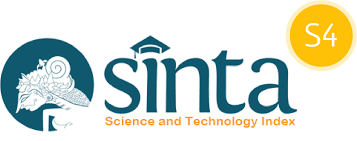Optimalisasi Prediksi Dalam Kelulusan Berbasis Deep Learning: Perbandingan Kinerja Multi-Layer Perceptron dan Deep Neural Network
DOI:
https://doi.org/10.29408/jit.v8i2.30756Keywords:
Deep Neural Network, Deep Learning, Graduation, Multi-Layer Perceptron, StudentsAbstract
Predicting on-time graduation is one of the significant challenges in education, aiming to model the factors influencing academic success. This study aims to compare the performance of two Deep Learning algorithms, namely Deep Neural Networks (DNN) and Multi-Layer Perceptron (MLP), in predicting on-time graduation. The methodology used involves evaluating both algorithms with various performance metrics, including Recall, Accuracy, Precision, AUC, MCC, and Cohen Kappa. The results show that DNN performs better in terms of Recall (0.9766), indicating its ability to capture most of the students who graduate on time, although its AUC (0.8625) and Precision (0.8803) are lower compared to MLP. On the other hand, MLP excels in Accuracy (0.8812) and Precision (0.9037), providing more stable results for MCC and Cohen Kappa, demonstrating a better balance in predicting students who graduate on time and those who do not. Overall, while DNN is more sensitive in capturing students who graduate on time, MLP performs better in terms of balance between accuracy and minimizing prediction errors. This study suggests using MLP if the primary priority is accuracy and prediction stability, while DNN is more suitable when the main focus is capturing as many students as possible who graduate on time.
References
[1]. U. R. Habibah and A. Solichin, “Prediksi Kelulusan Mahasiswa Dengan Metode Naive Bayes dan Artificial Neural Network : Studi Kasus Fakultas Teknik UNIS Tangerang,” Fakt Exacta, Vol 15, No.1, pp. 73-83, 2022.
[2]. W. H. A. P. Mudjihartono, “Kecerdasan Buatan Dalam Teknologi Kedokteran: Survey Paper,” Konstelasi: Konvergensi Teknologi Dan Sistem Informasi, vol. 2, no. no.1, 2022.
[3]. T. P. A. Y. A. M. Shandy, “Perbandingan Model Logistic Regression Dan Artificial Neural Network Pada Prediksi Pembatalan Hotel,” Jurnal Informatika Sunan Kalijaga (JISKA), vol. 6, no. no..1, pp. 29-37, 2021.
[4]. A. O. G. a. O. P. Tedyyana, “Model Design of Intrusion Detection System on Web Server Using Machine Learning Based.,” in Proceedings of the 11th International Applied Business and Engineering Conference, ABEC 2023, Bengkalis, Riau, Indonesia, 2023.
[5]. M. H. Diponegoro, S. S. Kusumawardani and I. Hidayah, “Tinjauan Pustaka Sistematis: Implementasi Metode Deep Learning pada Prediksi Kinerja Murid,” Jurnal Nasional Teknik Elektro dan Teknologi Informasi, vol. 10, no. no.2, pp. 131-138, 2021.
[6]. H. Nurdin, Sartini, Sumarna, Y. I. Maulana and V. Riyanto, “Prediction of Student Graduation with theNeural Network Method Based onParticle Swarm Optimization,” Jurnal Sinkron, vol. 7, no. no.4, pp. 2354-2362, 2023.
[7]. W. E. Pangesti, I. Ariyati, Priyono, Sugiono and R. Suryadithia, “Utilizing Genetic Algorithms to Enhance Student Graduation Prediction with Neural Networks,” Jurnal Sinkron, vol. 8, no. no.1, pp. 277-284, 2024.
[8]. S. Rukiastiandari, L. Rohimah, Aprillia and F. Mutia, “Predicting Graduation Outcomes: Decision Tree Model Enhanced with Genetic Algorithm,” Paradigma, vol. 26, no. No.1, pp. 1-6, 2024.
[9]. A. H. Kahfi, T. Prihatin, Yudhistira, A. Sudrajat and G. Wijaya, “The Right Steps Towards Graduation: Nb-Pso Smart Combination For Student Graduation Prediction,” Jurnal Teknik Informatik, vol. 5, no. No.2, pp. 607-614, 2024.
[10]. Sumarna, I. Nawawi, Suhardjono, H. Sugiarto and D. Yuliandari, “Meningkatkan Akurasi Prediksi Kelulusan Mahasiswa Menggunakan Metode Algoritma Genetika,” Jurnal Informatika, vol. 16, no. No.2, pp. 243-247, 2024.
[11]. Ridwansyah, M. Iqbal, H. Destiana, Sugiono and A. Hamid, “Data Mining Berbasis Machine Learning Untuk Analitik Prediktif Dalam Kelulusan,” Semantik, vol. 10, no. No.2, pp. 1-10, 2024.
[12]. V. Riyanto, A. Hamid and Ridwansyah, “Prediction of Student Graduation Time Using,” Indonesian Journal of Artificial Intelligence and Data Mining (IJAIDM), vol. 2, no. No.1, pp. 1-9, 2019.
[13]. “Analisis Prediksi Kelulusan Mahasiswa Menggunakan Decission Tree Berbasis Particle,” Jurnal SISFOKOM, vol. 9, no. No.1, pp. 102-107, 2020.
[14]. W. Suhardjono, “Prediksi Waktu Kelulusan Mahasiswa Menggunakan Svm Berbasis Pso,” Bianglala, vol. 7, no. No.2, pp. 97-101, 2019.
[15]. Ridwansyah, G. Wijaya and J. J. Purnama, “Hybrid Optimization Method Based On Genetic Algorithm For Graduates Students,” Pilar Nusa Mandiri, vol. 16, no. No.1, pp. 53-58, 2020.
[16]. D. Pardede, B. Hayadi and Iskandar, “"Kajian Literatur Multi Layer Perceptron : Seberapa Baik Performa Algoritma Ini,” Journal of ICT Aplication and System, vol. 1, no. no. 2, pp. 23-34, 2022.
[17]. D. Pardede, B. Herawan Hayadi, and Iskandar, “Kajian Literatur Multi Layer Perceptron: Seberapa Baik Performa Algoritma Ini,” Journal of ICT Aplication and System, vol. 1, no. 1, pp. 23–34, 2022.
[18]. V. K. Bakti, Dairoh, and M. Naufal, “Neural Network dan Particle Swam Optimization untuk Penunjang Keputusan Antipasi Mahasiswa Pra Lulus Bekerja Sesuai Bidang,” MATRIK : Jurnal Manajemen, Teknik Informatika dan Rekayasa Komputer, vol. 21, no. 1, pp. 151–158, 2021, doi: 10.30812/matrik.v21i1.1164.
[19]. Ali, L. Sularto, and K. Kunci, “Optimasi Parameter Artificial Neural Network Menggunakan Algoritma Genetika Untuk Prediksi Kelulusan Mahasiswa,” Jurnal ICT : Information Communication & Technology, vol. 18, no. 1, pp. 54–59, 2019, [Online]. Available: https://ejournal.ikmi.ac.id/index.php/jict-ikmi
[20]. C. N. Dengen, K. Kusrini, and E. T. Luthfi, “Implementasi Decision Tree Untuk Prediksi Kelulusan Mahasiswa Tepat Waktu,” SISFOTENIKA, vol. 10, no. 1, p. 1, Jan. 2020, doi: 10.30700/jst.v10i1.484.
[21]. D. Mardinah and M. Thoriq, “Algoritma Multi Layer Perceptron sebagai Prediksi Kelulusan Mahasiswa Universitas Adzkia Tepat Waktu berdasarkan jenis kelamin, Indeks Prestasi DatSemester, dan Jumlah SKS yang ditempuh,” Jurnal Rekayasa Sistem Komputasi dan Manajemen, vol. 1, no. 1, 2022, doi: 10.37034/jrskm.v4i4.1
Downloads
Published
How to Cite
Issue
Section
License
Copyright (c) 2025 Infotek: Jurnal Informatika dan Teknologi

This work is licensed under a Creative Commons Attribution 4.0 International License.
Semua tulisan pada jurnal ini menjadi tanggung jawab penuh penulis. Jurnal Infotek memberikan akses terbuka terhadap siapapun agar informasi dan temuan pada artikel tersebut bermanfaat bagi semua orang. Jurnal Infotek ini dapat diakses dan diunduh secara gratis, tanpa dipungut biaya sesuai dengan lisense creative commons yang digunakan.
Jurnal Infotek is licensed under a Creative Commons Attribution 4.0 International License.
Statistik Pengunjung




